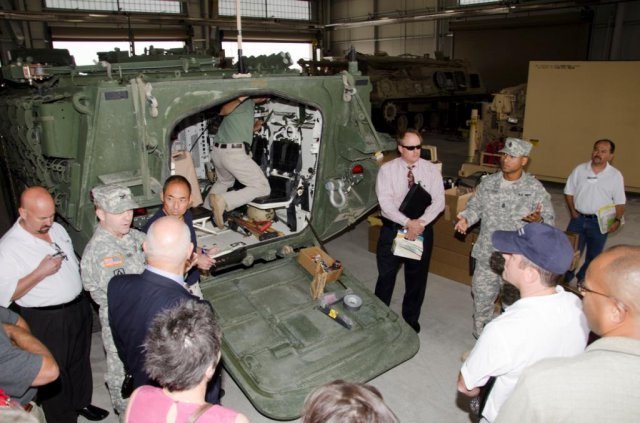The Army hosted an Industry Day for defense contractors Sept. 8 to introduce its new agile acquisition process and how the Network Integrated Evaluation supports it.
The event took place in El Paso, Texas and at White Sands Missile Range, N.M.
More than 150 representatives from 60 companies — both large defense corporations and smaller business entities — came to learn more about the Army’s testing and evaluation process and how they can participate in the Network Integrated Evaluations, or NIEs.
The NIEs are semi-annual evaluations designed to integrate and mature the Army’s tactical network and are a key element of the Army’s emerging Network Strategy.
The first evaluation — termed NIE 11.2 — was conducted in June/July and involved nearly 3,800 Soldiers and 1,000 vehicles of the 2/1 AD. The second iteration in the series, dubbed NIE 12.1, is slated for November 2011.
Entrance, evaluation and exit criteria, along with test and evaluation conditions were explained by leadership, while Soldiers emphasized the importance of working concrete training plans for the systems inducted in the NIEs as part of the Army’s new Agile Process.
“The Agile Process is truly a new way of doing business and this first Industry Day provided an important environment for industry and Army collaboration,” said Paul Mehney, chief of public communications for PEO Integration.
By employing the Agile Process, the Army is able to keep pace with technological advances, accelerating the pace of network modernization to a rate unachievable by traditional acquisition strategies. The Agile Process focuses primarily on meeting identified and prioritized capability gaps by integrating emerging technological solutions through iterative, pre-defined, predictable windows for testing and insertion that are aligned with the Army Force Generation, or ARFORGEN, process.
“We listened to feedback that industry provided on how we are managing the Agile Process and we intend to make improvements based on that. As we continue through solidifying the Agile Process, it needs to be a collaborative activity with industry and events like this are important steps in making that happen,” he said.
The full-day event familiarized industry with the NIE process, introduced the major Army organizations involved and their missions, and showed how the NIE’s evaluation brigade — 2nd Brigade, 1st Armored Division — is structured and what equipment it possesses.
“By allowing industry leaders to see how this unique brigade is structured and to talk with Soldiers who operate the equipment, (they) were able to familiarize themselves with potential integration challenges as they bring capabilities into the NIE process,” Mehney said.
Industry representatives were provided a first-hand look at the test/evaluation ranges and environmental conditions at WSMR. Various facilities where they will operate out of pre, during and post-NIE were toured.
During the inaugural Industry Day leaders from the Brigade Modernization Command, Army Test and Evaluation Command, and Program Executive Office Integration, known as PEO I — a group known as the “TRIAD” — demonstrated how the NIEs support the Army’s overarching network strategy to create a mobile, secure, wireless battlefield network for our Soldiers.
Keying off lessons learned from NIE 11.2, service leaders repeatedly stressed the Army’s commitment to providing network connectivity and Mission Command capabilities to the small unit (company and below) — the dismounted Soldier at the tactical edge who represents the Army’s most challenged and vulnerable user.
Future NIE players left Industry Day with a better understanding of the Army’s new business model.
“This is an incredible industry day,” commented one industry representative. “The Army has set the mark really high by using the panel presentations and motor pool tours to clearly articulate the process and address industry concerns.”
Approximately 50 networked and non-networked technologies will be assessed during NIE 12.1. The primary purpose will be to continue required evaluations in support of Program of Record milestones, and advance the integration and understanding of the Army’s objective and bridge network architectures.
It will also begin to establish the Objective Integrated Network Baseline, common connectivity across the Brigade Combat Team structure, and introduce industry participation in the NIE evaluation cycle.
This second NIE will build off lessons learned from the June and July NIE evaluation in order to support the Army’s holistic focus to integrate network components simultaneously in one operational venue.










